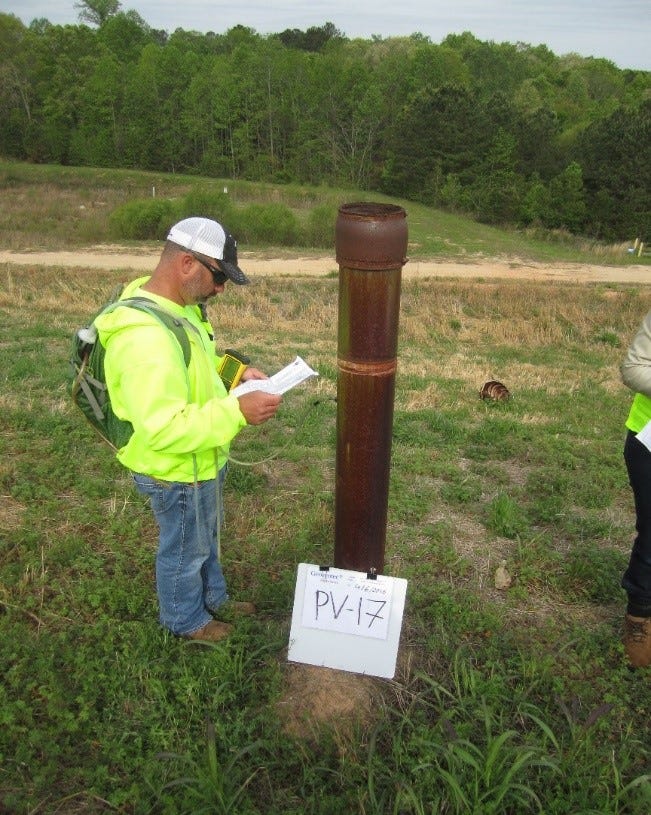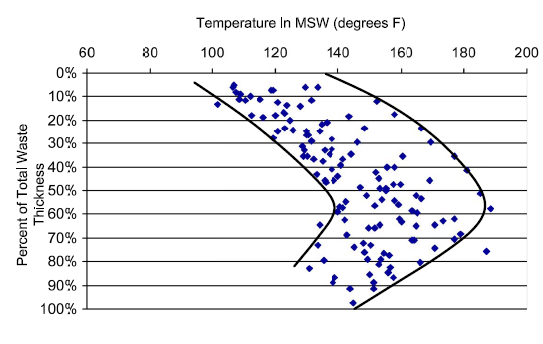Diagnosing and Understanding Elevated Temperature Landfills (Part 1)
The first of a three-part series, this article talks about characteristics and challenges associated with ETLFs and their management.
This is Part 1 in a three-part series. Click to read Part 2 and Part 3.
A very small percentage of municipal solid waste (MSW) landfills in North America have reported elevated and increasing temperatures above those normally associated with a “hot gas well.” Temperatures above 150°F or even 250°F have been reported in some cases. Some of these elevated temperature landfills (ETLFs), have received industrial wastes that may release heat, while others have not. Considerable uncertainty exists regarding why some landfills exhibit elevated and increasing temperatures.
This article is the first of a three part series providing an overview of ETLFs. It was developed by a team of engineers studying the underlying mechanisms that lead to ETLFS under sponsorship of the Environmental Research and Education Foundation (EREF). This part (Part 1) talks about characteristics and challenges associated with ETLFs and their management. Part 2 will discuss biological reactions that occur in landfills and how they contribute heat. Part 3 will provide a discussion on chemical reactions. The focus of this article is on situations in which the heat is not a result of air intrusion and/or a fire or smoldering combustion, but rather the result of processes contributing to elevated temperatures that are occurring under anaerobic conditions deep in the landfill.
(Elevated temperature landfills will also be the subject of an upcoming Waste360 webinar on Dec. 14, 2016. To register for the webinar, click here.)
Challenges of elevated temperature landfills
ETLFs pose a number of challenges that vary from site to site. The ETLFs that we have observed have generally had the maximum temperature near the vertical mid-point of the landfill with the waste near the surface and adjacent to the liner being cooler. Challenges may include regulatory compliance, damage to gas and leachate infrastructure, rapid settlement, low methane gas content, fugitive gas emissions and odor complaints, increasing leachate volumes with increasing chemical oxygen demand (COD) and salt content.
Potential infrastructure damage at an ETLF includes softening and buckling of the components of the gas and leachate extraction systems. A damaged gas collection system may lead to fugitive emissions and odor complaints, while a compromised leachate extraction system may result in leachate seeps, elevated head on liner and flooded gas wells.
The landfill gas (LFG) at an ETLF may have unique odors as well as low methane content. These may be indicators of impending elevated temperature conditions and as such, emphasize the importance of routine monitoring at the LFG wellheads (Figure 1). Typically, the overall methane content remains rich enough to support adequate combustion at the flare; however, in some cases, a temporary flare may be required to separately treat low methane content LFG from an affected area so it does not mix with gas from the remainder of the landfill. It may also be necessary to provide supplemental fuel to insure complete combustion at the flare.
 Figure 1. Checking LFG at well heads is important to for early detection of possible development of ETLF conditions.
Figure 1. Checking LFG at well heads is important to for early detection of possible development of ETLF conditions.
High leachate COD and salt concentrations have also been associated with ETLFs. These characteristics can lead to higher costs for treatment or even the refusal of a local wastewater treatment plant to accept the leachate. Elevated temperatures may also result in slope instability due to reduced waste strength or increased liquid or gas pore pressures, sinkholes, and rapid settlement. Finally, elevated temperatures have resulted in demands to initiate increased operations, oversight and litigation.
Given the myriad of potential issues associated with ETLFs, there is considerable interest in understanding their origin, and in developing management strategies and design guidelines to avoid the potential for more ETLFs in the future.
Do I have a landfill fire or an ETLF?
A landfill fire requires the availability of oxygen and typically occurs at or near the landfill surface. Fires have two basic variations and both require oxygen to be sustained:
Surface fires that might be caused unintentionally by cigarettes, sparks, or natural phenomena such as lightning strikes; or
Subsurface fires or combustion (often referred to as “SOE”, or “subsurface oxidation event”).
In contrast to ETLFs (which affect many wells and large areas), SOEs usually affect only one well and a very small area. Small, sharp subsidence features, surface charring and smoke are the visual hallmarks of an SOE. There are many potential causes of SOEs, examples of which include:
Co-disposal of ash that is not completely extinguished before being placed in the landfill and initiates combustion of the MSW.
Improperly designed landfill gas (LFG) collection systems that result in air infiltration. For example, wells that were installed without surface seals or too close to exposed slopes.
Improperly operated LFG collection systems, where air is drawn into the waste by:
initiating a vacuum in horizontal LFG collector pipes prior to adequate amounts of waste being placed over the pipes; or
applying too much vacuum on horizontal collectors or vertical wells
In contrast to a traditional fire, there are a number of chemical and biological heat generating reactions that occur in landfills in the absence of oxygen. These types of reactions are the focus of ongoing research and will be described in Parts 2 and 3 of this series.
Carbon Monoxide, Hydrogen and Gas composition trends
Elevated concentrations of hydrogen (H2) and carbon monoxide (CO) may indicate the presence of a problem. One criterion for assessing the presence of a fire is the presence of CO in LFG. Guidelines by FEMA indicate:
CO levels ranging up to 100 ppm indicates a low probability of fire;
CO levels from 100 to 1000 ppm indicate that a fire may possibly exist;
CO levels greater than 1000 ppm indicate a strong likelihood of fire.
Caution must be exercised when measuring CO levels in gas, especially when using hand-held meters simultaneously reporting CH4, CO2, O2, CO, and balance gas (assumed to be N2). The manufacturers of some meters have indicated that high levels of H2 may be mistaken for CO. In addition, because H2 is not measured directly by most hand-held meters, the user may assume that the elevated balance gas is only N2 when it is actually N2 + H2. Given that CH4 and CO2 are normally the primary constituents in LFG, the presence of high H2 concentrations is atypical. Thus, the accumulation of H2, as is sometimes observed in ETLFs, indicates that typical landfill biological processes have been interrupted.
Therefore if a field meter indicates high CO or balance gas, and there is a trend of increasing gas well temperatures, then consider having gas samples analyzed by an accredited laboratory to determine if CO and H2 are present. Elevated H2 would suggest an ETLF as opposed to a landfill fire or SOE.
Trends in the gas well temperature and the concentrations of CH4, CO2, and balance gas should also be reviewed. Landfill operators have reported that a decreasing trend in the CH4/CO2 ratio is a leading indicator of temperature increases to a level at which biological methane generation is interrupted. Because the CH4/CO2 may be a leading indicator, decreases may be observed before the gas temperature increases. Figure 2 shows how this ratio may decrease abruptly, emphasizing the importance of regular monitoring and data review.

Figure 2. CH4/CO2 ratio over time at an ETLF noting that this ratio may decrease rapidly.
Observation of the vertical distribution of temperatures throughout the waste
If the temperature of the gas increases with depth into the waste (much beyond the top of the slots in the gas extraction wells), then fire is not likely. A vertical distribution of waste temperatures for a representative ETLF is shown in Figure 3. Here, the temperature is highest in the middle where oxygen is least likely to be available.

Figure 3. Vertical profile showing highest temperatures near mid-point where the oxygen is least available.
Is managing a subsurface fire the same as managing an ETLF situation?
There are similarities, but there are also important differences. If the information points to a SOE or active combustion in the landfill, then the fire should be extinguished following established protocols. Extinguishing a fire is focused on suppressing oxygen or potential sources of oxygen. That usually involves turning down LFG flow to minimize the introduction of air into the waste. Once extinguished, it may be beneficial to cool the waste where possible to avoid the accumulation of heat that could stimulate reactions that do not require oxygen. The feasibility of this will depend on the depth and volume of the affected waste mass.
In the case of an ETLF, there are number of steps that can be taken to manage the landfill. To begin, it is important to continue to remove gas from the landfill. This is because volatile organics may serve as a fuel to sustain the ETLF condition. Removing gas translates into removing fuel (Part 3 will describe this in more detail). The gas removal must be done carefully to avoid pulling air into the waste. In cases where the screened intervals of the LFG wells are shallow or are near exposed waste slopes, then consideration should be given to installing temporary or interim covers to reduce air infiltration.
Summary
In summary, ETLFs are different from landfills that are experiencing surface fires or SOEs. While both situations exhibit heat and likely elevated CO, ETLFs are likely to exhibit low CH4/CO2 ratios, may produce hydrogen and result in increased leachate quantity and strength. Removing gas from ETLFs is important as the gas contains volatile organics that provide fuel for the reactions. Thus, dialog with regulators is important to develop a management strategy that is appropriate. The operator may also want to evaluate slope stability and prepare for the potential for increased volumes of leachate with elevated contaminants.
About the Authors
You May Also Like


